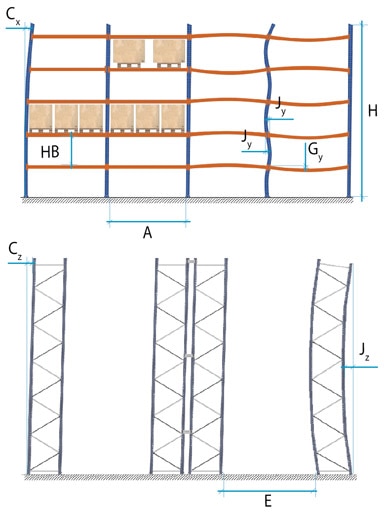As well as machinery, leveling also affects the racking units. Racking units must have a particular clearance once assembled and before being loaded. Again, it is EN 15620 standard that provides the acceptable parameters. These parameters must be observed in order to avoid the potential problem of machines colliding with the structures or hitting them when positioning loads into spaces.
Clearance values will depend on the type of facility and its class (100, 200, 300, or 400), with the data set out in the attached table referring to classes 300 and 400. The illustration accompanying the table indicates to which element each measure applies.

A: Clear width of the space.
E: Clear width of the aisle.
Cx: Lack of verticality.
Cz: Lack of verticality.
Jy: Straightness of the upright.
Jz: Straightness of the upright.
Gy: Straightness of the beam.
H: Height from the top of the base plate to
the top of the upright.
HB: Height from the top of a beam to the
top of the beam at the next level.
| Class | Clearances (in) | ||||||
| A | E | Cx | Cz | Jx | Jz | Gy | |
| 300 | ± .12 | ±.20 | +/-H/19.7 | +/-H/19.7 | ±.12 or ±HB/29.5 | +/-H/19.7 | ±.12 or ±A/19.7 |
| 400 | ±.12 | ±.59 | +/-H/13.8 | +/-3 o +/-HB/13.8 | ±.12 or ±HB/15.7 | ±H/19.7 | ±.12 or ±A/19.7 |
In addition to the parameters set out above, the specific clearances contained in the standard EN 15620 must be adhered to.
